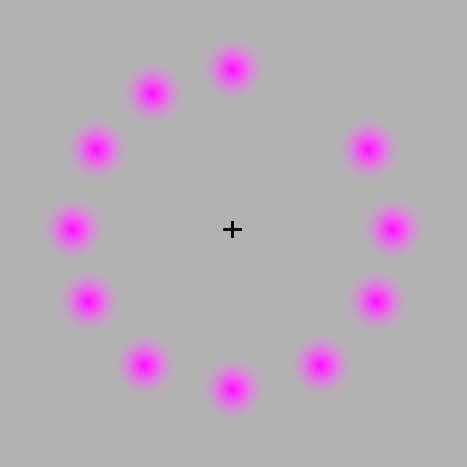Part 3: Colour and Contrast.
Itten's contrasts all happen at the same time and they all impact how we perceive and see colours.
Itten's 7 Contrasts:
•
Contrast of TONE
•
Contrast of HUE
•
Contrast of SATURATION
•
Contrast of EXSTENSION
•
Contrast of TEMPERATURE
•
COMPLEMENTARY contrast
•
SIMULTANEOUS contrast
Contrast of tone:
The contrast of tone is the juxtaposition of light and dark values, they can also exist within monochrome.
As an example below the colour wheel shows the colours all the same chromatic values, but when they're monochrome they show the many values of tone within the different hues. Blue been the heaviest and darkest colour while yellow the exact opposite at white.
Contrast of hue:
Contrast within hue also exists, as previously mentioned blue is one of the visually heavier hues, red is a mid-tone while yellow exists as a lighter visual weight. When placed on white, the blue is the colour you're drawn to most because it has higher contrast with the white than the red or yellow does.
However when placed onto the black background the yellow is the one visually pushed forward due to it's hue's higher contrast with the black on the background.
Contrast of Saturation:
Contrast of saturation is the differentiation between the light and dark values combined with their relative saturations. So for example, below the first cross is rather desaturated, bringing the next cros on top of it we visually perceive as been desaturated more as the blue gets more pure in the middle. Adding the final blue square then desaturates the cross behind and the same again, it's the next bluesest thing we see so the behind are desaturated by it.
Contrast of Extension:
The contrast of exstention/proportion is the sizes in relation to the visual weight of the colour, so again as an example when the two complementaries come together they have a high contrast, it is visually jarring to look at.
This is corrected by proportionally correcting the colours as with the example above, when there is more of one colour than the other. It helps balance the contrast, where as below with equal amounts the picture becomes waves and creates an after-image.
Contrast of Temperature:
The contrast of temperature is created by the forming of the hues that can be considered 'warm' or 'cool', This is also known as the contrast of warm and cool. Two of the colours considered warm and cool would be obvious ones of Red/Orange and Blue.
To see this in effect when putting the colours together in sequential order like this, even though they are all of solid colour, we perceive to see a gradient appearing on them due to the development of the temperature along the colours changing.
Complementary contrast:
Complementary contrast is created by the juxtaposing complementary colours on a color wheel or perceptual opposites to each other. Black and white been one, or Red and green too. They collide with each other and are rather difficult to look at.
It doesn't make for easy reading.
Simultaneous contrast:
Simultaneous contrast is created when the boundaries between the colours perceptually vibrate, if you start long enough you'll have an after image. Also occurs when there is neutral colour and a high contrasting one. So for example the yellow creates violet in the negative space when you stare at it long enough because no-matter what colour will impose it's complimentary colours.
Colour contrast task:
We got 5 red objects as well as 5 green objects to then look at on the different coloured papers, we were to say which were the lowest/mid/highest contrasting with the objects and paper. Below are the results we found from the task, with red contrasting mostly with the greens and lowest contrast was found within the red.
Fanta Can
Lowest Contrast
Mid Contrast
Highest Contrast
Coca Cola Label
Lowest Contrast
Mid Contrast
Highest Contrast
Pencil
Lowest Contrast
Mid Contrast
Highest Contrast
Ibuprofen
Lowest Contrast
Mid Contrast
Highest Contrast
River Island Bag
Lowest Contrast
Mid Contrast
Highest Contrast
Part 4: Subjective Colour.
Because of contrasting colours, in word below Type is read by the letters because the yellow stands out from the complimentary violet because it's pushed out from it. Where as when it's reversed we still read it but by the negative space/ the counters because we're drawn to the yellow rather than the purple because it's easier to read that way.
Because colours contrast in this way, it makes knowing what the colour is subjective depending on the colours surrounding it. Here the lime green within the yellow is one solid color, adding in another colour to the side makes it alot more yellow just because of the one next to it, it takes on the colour from the other side. Still been a solid colour however.
This can happen to neutral colours taking in more contrasting colours, so for example the green here makes the grey bold seem a bit more violet because of the greens complimentary colour forcing it's self to exist so we perceive it. This then does the same for the violet making the bold come off a bit more green when in fact they're still the same colour. It's just how the colours are making us perceive it.
Even when the colours no longer exist they leave behind a complimentary negative after-image ingrained into the back of our eyes, a good example of this is the illusion image below, stare and the cross in the middle and as the pink dot spin you'll see a green copy of the circle of dots even though they don't exist.

























































No comments:
Post a Comment